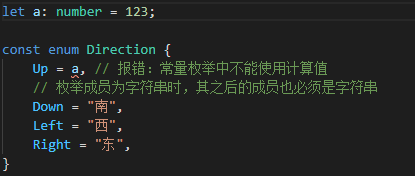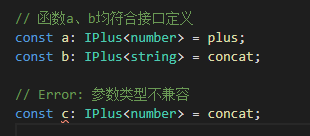外观
基础用法
静态类型
typescript
/** count
* 不可以为其他类型
* 编辑器会提示数字类型的所有方法
*/
const count: number = 2021基础类型和对象类型
基础类型: boolean, number, string, void, undefined, symbol, null
对象类型: {}, Class, function, []
typescript
// 对象类型
class Person {}
const teacher: {
name: string
age: number
} = {
name: 'Zws',
age: 18
}
const numbers: number[] = [1, 2, 3]
const zws: Person = new Person()
// 对象类型-函数的两种写法儿
// 第一种(可以忽略 number,类型推断会推断出返回值是number)
const func = (str: string): number => {
return parseInt(str, 10)
}
// 第二种(可以理解为:冒号后面跟的是函数的类型,等号后面是函数体。不能忽略number,不然语法错误)
const func1: (str: string) => number = str => {
return parseInt(str, 10)
}类型注解和类型推断
类型推断(type inference):TS 会自动的去尝试分析变量的类型。例如:
typescript
// 这就是典型的类型推断,它们的类型是 number 而且值永远都不会变的
const firstnumber = 1
const secondNumber = 2
const total = firstNumber + secondNumber类型注解(type annotation) :告诉 TS 变量是什么类型。例如:
typescript
// 当 TS 无法推断出变量类型的时候需要添加类型注解
function getTotal(firstNumber: number, secondNumber: number) {
return firstNumber + secondNumber
}
const total = getTotal(1, 2)
// 其他的情况
interface Person {
name: string
}
const rawData = '{"name": "zws"}'
const newData: Person = JSON.parse(rawData)
// 一个变量是一个数字类型,后续要变成字符串。类似或运算符
let temp: number | string = 123
temp = '456'函数相关类型
typescript
// void类型:没有返回值
function sayHello(): void {
console.log('hello')
}
// never类型:函数执行不完
function errorEmitter(): never {
while (true) {}
}
// 函数的解构赋值
function add({ first, second }: { first: number; second: number }): number {
return first + second
}
add({ first: 1, second: 2 })数组和元组
数组
typescript
// 数组可以是数字和字符串类型
const numberArr: (string | number)[] = [1, 2, 3]
// undefined 数组
const undefinedArr: undefined[] = [undefined, undefined, undefined]
// 存储对象类型的内容
const objectArr: { name: string; age: number }[] = [
{
name: 'zws',
age: 18
}
]
// 使用类型别名(type alias)
type User = { name: string; age: number }
// 存储对象类型的内容
const objectArr: User[] = [
{
name: 'zws',
age: 18
}
]
// 关于 Class
class Teacher {
name: string
age: number
}
const objectArr: Teacher[] = [
new Teacher(),
{
name: 'zws',
age: 18
}
]元组 tuple
数组长度和类型都固定的情况下,可以使用元组进行管理
typescript
const teacherInfo: [string, string, number] = ['zws', 'jon', 18]
const teacherList: [string, string, number][] = [
['zws', 'jon', 18],
['sun', 'dea', 22],
['za2', 'wall', 26]
]Interface 接口
TIP
interface 和 type 相类似,但不完全一致,type 可以校验基础类型,而 Interface 不支持基础类型的校验。
TS 里,能使用 Interface 的话就使用 Interface。
- 接口只是 TS 帮助我们校验的工具,并不会变成 JS
- 属性前加上?,代表该变量可有可无
- 属性前加上 readonly,代表只读不可修改
typescript
interface Pereson {
name: string
age?: number
readonly test: string
}
const getPersonName = (person: Pereson) => {
console.log(person.name)
}
const setPersonName = (person: Pereson, name: string): void => {
person.name = name
}
const person = {
name: 'zws',
age: 18,
sex: 'male'
}
getPersonName(person)
setPersonName(person, 'lin')- 如果以字面量的形式传给函数,TS 会进行强校验。例如:
typescript
interface Pereson {
name: string
age?: number
}
const getPersonName = (person: Pereson) => {
console.log(person.name)
}
const setPersonName = (person: Pereson, name: string): void => {
person.name = name
}
const person = {
name: 'zws',
age: 18,
sex: 'male'
}
getPersonName({
name: 'zws',
age: 18,
sex: 'male'
}) // 会报错,sex不在 Person 种
setPersonName(person, 'lin')
// 修改 Interface 解决(最后一行代表的是,可以是任何字符串类型的键,任何值)
interface Pereson {
name: string
age?: number
[propName: string]: any
}- Interface 里支持方法的写入
typescript
interface Pereson {
name: string
age?: number
say(): string
}
const person = {
name: 'zws',
say() {
return 'say hello'
}
}- class 类应用接口
typescript
interface Pereson {
name: string
age?: number
say(): string
}
// 语法 implements
class User implements Pereson {
name = 'zws'
say() {
return 'say hello'
}
}- 接口之间互相继承
typescript
// 关键字 extends
interface Teacher extends Pereson {}- 接口定义函数
typescript
interface SayHi {
(word: string): string
}
const say: SayHi = (word: string) => {
return word
}interface 小案例, 公用属性使用 Interface 进行扩展:
typescript
interface Person {
name: string
}
interface Teacher extends Person {}
interface Student extends Person {
age: number
}
const teacher = {
name: 'zws'
}
const student = {
name: 'has',
age: 18
}
const getUserInfo = (user: Person) => {
console.log(user.name)
}
getUserInfo(teacher)
getUserInfo(student)class 类
类的定义与继承
typescript
// 类里写属性与方法
class Person {
name = 'zws'
getName() {
return this.name
}
}
const person = new Person()
console.log(person.getName()) // zws
// 继承类,继承类属于字类,被继承的属于父类
class Teacher extends Person {
getTeacherName() {
return 'zws Teacher'
}
// 子类可以重写父类的属性与方法
getName() {
// super 关键字指向了父类,可以直接调用父类。不会受到类重写的影响
return super.getName() + 'TTT'
}
}
const teacher = new Teacher()
console.log(teacher.getName()) // zws
console.log(teacher.getTeacherName()) // zws Teacher类的访问类型
访回类型:
- private:允许在类内使用
- protected:允许在类内及继承的子类中使用
- public:允许在类的内外调用(默认)
自带方法:
- readonly:只读属性
- static:将方法挂载到类上而不是实例上
TIP
直接写在类里的属性或函数,相当于前面加了 public
typescript
class Person {
protected name: string = '123'
private age: number = 10
public sayHi() {
console.log('hi' + this.age)
}
}
class Teacher extends Person {
public sayBye() {
return this.name
}
}
const person = new Person()
person.sayHi()
const teacher = new Teacher()
console.log(teacher.sayBye())构造器 constructor
constructor 会在 new 实例的时候自动执行
typescript
// 以下两段代码相同, constructor 里,参数前加上public代表在之前已经声明过这个变量了
// 传统写法
class Person {
public name: string
constructor(name: string) {
this.name = name
}
}
const person = new Person('zws')
// 简化写法
class Person {
// public name: string
constructor(public name: string) {
// this.name = name
}
}
const person = new Person('zws')
console.log(person.name)字类集成父类并使用 constructor 的话,必须先调用父类的 constructor ,并按照父类的参数规则进行
typescript
// super()代表调用父类的 constructor
// 如果父类没有使用constructor 字类需要调用一个空的super()
class Person {
constructor(public name: string) {}
}
class Teacher extends Person {
constructor(public age: number) {
super('zws')
}
}
const teacher = new Teacher(28)静态属性,Setter 和 Getter
Getter:读
Setter:写
typescript
// 可以通过getter访问私有属性,通过setter更改私有属性
// 一般用于对数据的加密
class Person {
constructor(private _name: string) {}
get name() {
return this._name + ' has'
}
set name(name: string) {
const realName = name.split(' ')[0]
this._name = realName
}
}
const person = new Person('zws')
console.log(person.name)
person.name = 'zwsa has'
console.log(person.name)做个小案例
通过 TS 创建一个 Demo 类,这个类只能被调用一次 思路:
- 不能在外部以 new Demo 的形式创建一个实例(将 constructor 设置为私有属性)
- 使用 static (将方法挂载到类上而不是实例上)来实现
- 使用 instance 方法来保存传入的值,并判断
typescript
class Demo {
private constructor(public name: string) {}
private static instance: Demo
static getInstance(name: string) {
if (!this.instance) {
this.instance = new Demo(name)
}
return this.instance
}
}
const demo1 = Demo.getInstance('zws')
const demo2 = Demo.getInstance('zwsa')
console.log(demo1.name)
console.log(demo2.name)抽象类
- 只能被继承,不能实例化
- 抽象类里的抽象方法,不能够写具体实现
typescript
abstract class Gemo {
width: number
getType() {
return 'Gemo'
}
abstract getArea(): number
}
class Cricle extends Gemo {
// 子类继承了抽象类,里面的抽象方法必须实现一下
getArea() {
return 123
}
}
class Square {}
class Triangle {}Enum 枚举
你可以使用常量const描述某种不会改变的值。但某些值是在一定范围内的一系列常量,如星期(周一~周日)、三原色(红黄蓝)、方位(东南西北)等,这种类型的值称为枚举。
数值枚举
使用关键字 enum 来声明一个枚举类型数据。
TIP
枚举成员默认为数值类型
typescript
enum Direction {
Up,
Down,
Left,
Right
}
console.log(Direction.Up) // 0
console.log(Direction[0]) // "Up"未赋初始值的枚举项会接着上个项的值进行递增。
使用 tsc 将上述代码编译为 js 后,可以发现 ts 使用 Direction[(Direction["Up"] = 0)] = "Up" 这样的内部实现对对象成员进行了双向的赋值。
由此可以看出,enum 具有双向映射的特点。
javascript
var Direction
;(function (Direction) {
Direction[(Direction['Up'] = 0)] = 'Up'
Direction[(Direction['Down'] = 1)] = 'Down'
Direction[(Direction['Left'] = 2)] = 'Left'
Direction[(Direction['Right'] = 3)] = 'Right'
})(Direction || (Direction = {}))
console.log(Direction.Up) // 0
console.log(Direction[0]) // "Up"字符串枚举
枚举成员为字符串时,其之后的成员也必须是字符串。
typescript
enum Direction {
Up, // 未赋值,默认为0
Down = '南',
Left = '西',
Right = '东'
}常量枚举
你可以使用const和enum关键字组合,声明一个常量枚举。 常量枚举中不允许使用计算值(变量或表达式)

Generics 泛型
泛型指的是,在定义函数、接口或类的时候不预先指定数据类型,而在使用时再指定类型的特性。
泛型可以提升应用的可重用性,如使用其创建组件,则可以使组件可以支持多种数据类型。
假如需要一个函数,返回传入它的内容 不使用泛型时,它会是这样的:
typescript
function echo(arg: any) {
return arg
}但这样就丢失了一些信息:传入的类型与返回的类型应该是相同的。如果我们传入一个数字,我们只知道任何类型的值都有可能被返回。于是此时需要一种方法使返回值的类型与传入参数的类型是相同的。
类型变量
这是一种特殊的变量,只用于表示类型而不是值。 使用泛型改写上述函数:
typescript
// 类型变量也遵循标识符定义规范,写为T只是习惯上这么做
function echo<T>(arg: T): T {
return arg
}这样,传入实参时,会同时将实参的类型传递给类型变量 T,同时返回值也是 T。
场景:交换两个数组元素
不使用泛型会丢失数据类型:
typescript
function swap(tuple) {
return [tuple[1], tuple[0]]
}使用泛型后,不仅会保有类型推断,还可以直接调用实例的方法:
typescript
function swapGeneric<T, U>(tuple: [T, U]): [U, T] {
return [tuple[1], tuple[0]]
}
const result2 = swapGeneric(['string', 0.123])
// ts的类型推断系统能够明确得知第一个元素会是数值,而第二个元素会是字符串
result2[0].toFixed(2)
result2[1].toLocaleUpperCase()约束泛型
假设有这样一个场景: 有时想操作某类型的一组值,并且我们知道这组值具有什么样的属性。下例中,我们想访问 arg 的 length 属性,但是编译器并不能推断每次传入的参数都有 length 属性,于是就报错了。
typescript
function echoWithArray<T>(arg: T): T {
console.log(arg.length) // Error: T doesn't have .length
return arg
}经过不充分的考虑后,我们尝试将类型变量指定为数组:
typescript
function echoWithArray<T>(arg: T[]): T[] {
console.log(arg.length)
return arg
}此时你也许会发现,这样只能传入数组,不能传入同样具有 length 属性的字符串、类数组对象等。
我们可以定义一个接口来描述约束条件,然后由类型变量继承此接口实现泛型约束:
typescript
// 一些编程规范约定接口以大写 I 作为前缀
interface IWithLength {
length: number
}
function echoWithLength<T extends IWithLength>(arg: T): T {
console.log(arg.length)
return arg
}
// 只要包含 length 属性且为数值 均不会报错
const str1 = echoWithLength('str')
const obj = echoWithLength({ length: 10, width: 10 })
const arr2 = echoWithLength([])泛型类
场景:定义一个类,能实现被 push 入的队列元素与 pop 出的元素的类型一致。
typescript
class Queue<T> {
private data = []
push(item: T) {
return this.data.push(item)
}
pop(): T {
return this.data.pop()
}
}
//泛型类实例化时要指定具体的类型
const queue = new Queue<number>()
queue.push(1)
queue.push('str') // Error: 类型“string”的参数不能赋给类型“number”的参数。泛型接口
万能的泛型同样可以用来描述接口:
typescript
interface KeyPair<T, U> {
key: T
value: U
}
// 泛型接口描述的对象,同样需要满足类型要求
let kp1: KeyPair<number, string> = { key: 123, value: 'str' }
let kp2: KeyPair<string, number> = { key: 'test', value: 123 }
// 描述函数的泛型接口
interface IPlus<T> {
// 函数应具有两个形参,和一个返回值,它们的类型相同
(a: T, b: T): T
}
function plus(a: number, b: number): number {
return a + b
}
function concat(a: string, b: string): string {
return a + b
}参数类型不兼容:

上次更新: